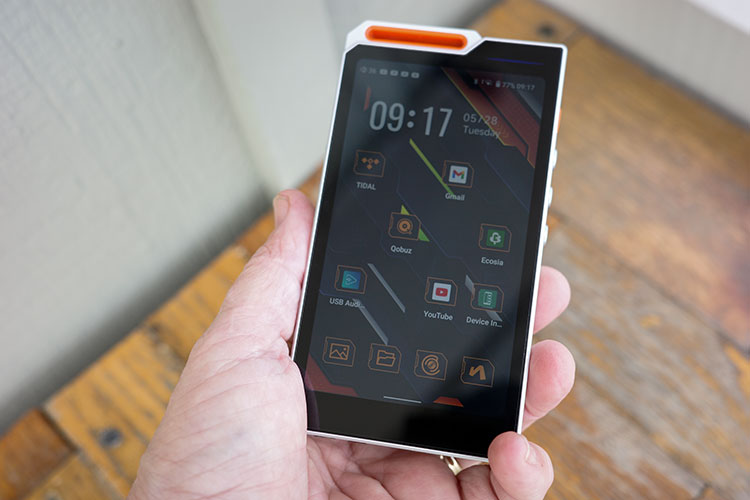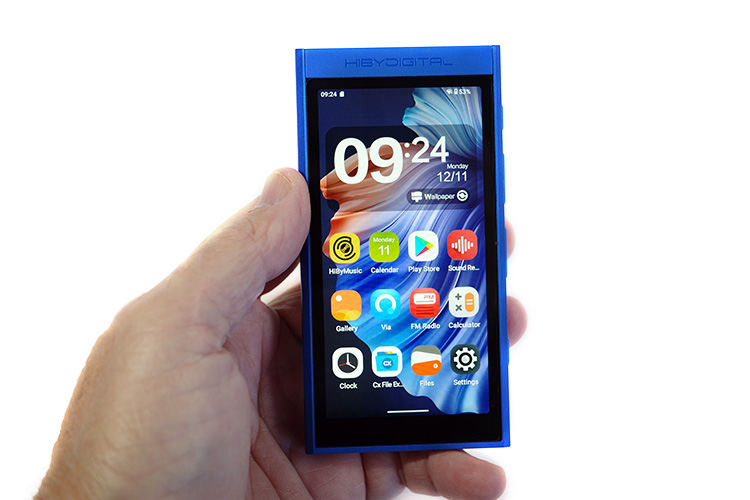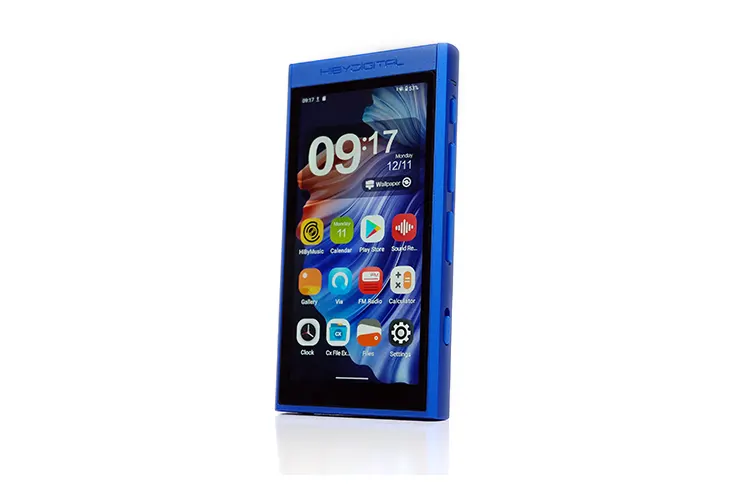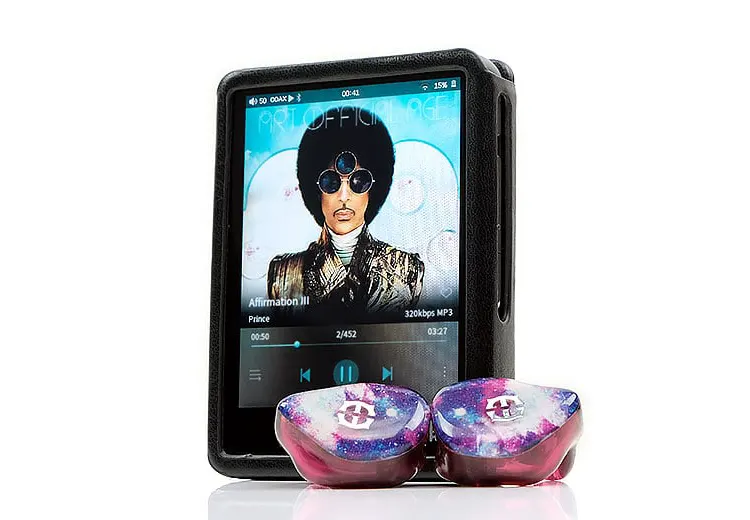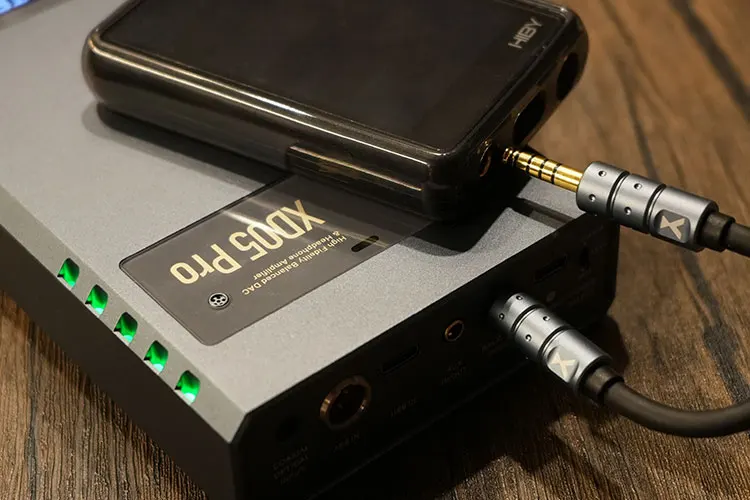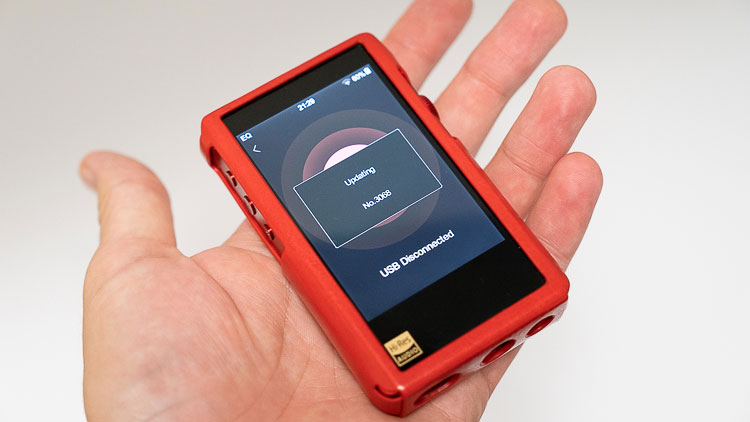Select Comparisons
The following comparisons were made using only the included HiBy x FAudio Project ACE IEMs on the 3.5mm SE jack. I felt this would give the best comparative interpretation even though I may personally prefer to use other combinations.
HiBy M300
From my synopsis: The more I listened to the HiBy Digital M300, the more I appreciated its multi-functional capabilities for media in general.
Android 13 is top-notch, and the ability to tailor your settings as noted above helps personalize the media experience.
It isn’t the most powerful, nor feature-laden DAP, but it is still worth a look as an affordable media player, or the one which you can carry with you to the gym or when you want something a bit extra. This is a very nice portable device.
That said, it is easy to see that the R4 has surpassed the M300 in most ways.
Technical
The HiBy Digital M300 runs Android 13. This is higher than many TOTL DAPs currently on the market. The HiByMusic app comes pre-loaded, which is an excellent music app in its own right. An FM radio app also comes preloaded for use.
The M300 battery gets you 29 hours of uptime with the 2000mAh battery and a standby time of 15 days (verified as I had to charge the device for this comparison). Dedicated playback time varied, but I was able to get upwards of 15 hours repeatedly. Slow charging is standard, but faster charging occurs with the right hookup up to 5V/1.5A.
Wireless capability of 2.4gHz and 5.0gHz and BT5.0 via the Qualcomm Snapdragon 665 provides for quick downloading or streaming capabilities from your favored music app.
Decoding Capability
Running a single Cirrus Logic CS43131 DAC chip, the performance is right for the market. Combining low-power audio with a high-fidelity headphone amplifier, the chip minimizes battery use for longer listening times.
Used across many devices, the chip is capable of running much higher-impedance headphones. The use here is appreciated.
Support for many of the highest audio codecs follows, with the capability of up to DSD256, and PCM768kHx/32bit. BT5.0 comes with LDAC, AAC, SBC, and aptX via a future firmware update.
Amplification
The M300 will not wow you with numbers, having “only” a maximum of 103mW. But under settings, then “sound & vibration” you can use the “Media volume” slider on a scale from 0-15.
This acts as a moving gain selector, instead of a hi/low switch. On the max of 15, and with the volume set under ½ for the “Master volume,” the volume was plenty loud. Simple numbers can be deceiving.
The amplification can also go through the included speaker. That speaker can be used across many situations, or the M300 can be connected to a BT-capable speaker.
Design
Form Factor
The M300 takes on the familiar rectangular shape of other DAPs or Smartphones (but much smaller in scale), with an easy-to-grasp shape. With dimensions of 113mm x 58mm x 13mm, the M300 clocks in at only 136g.
The 4” screen takes up most of the front, but there are sufficient bevels around the edge so you do not inadvertently hit the screen.
With the combination of Android 13, and 1280 x 640 resolution the picture is clear, bright, and sharp (much sharper than the Tempotec V6 & Shanling M2x). Adjusting the screen and customization follow Android guidelines, with many options available.
A front screen protector comes pre-mounted. All you have to do is pry off the protective plastic layer like you would on your Smartphone.
The M300 fits into your hand easily, and while it may be smaller than higher-end DAPs, the size is very workable when operating, fitting into my cargo pockets with no issue.
Aesthetics
The blue anodized color of the unibody aluminum chassis looks sharp and I was quite happy this color was sent. The anodization is as tough as it comes, and I do not worry about longevity. I even tried scratching the blue to gauge quality. It did not scratch.
Both the front and back are glass of similar quality. That said, the back felt like a clear plastic piece to me. This too bodes well for longevity, with no scratches, either (the screen protector showed minor scratches fairly quickly, though).
The beveled edges of the sides fit your hand well, giving a solid feel with no worry of dropping the unit. Made for right-handed people, I could still easily operate the M300 in my left hand, due to the smaller size. Those edges helped keep the M300 in place when operating, and I rarely hit buttons by mistake.
The lanyard hole on the bottom left side is right above the 3.5mm jack, which may not be a bad idea for this device. You can keep it in one hand or drop it if you need access to your Smartphone. Two microphone holes also sit on top for easy use if you need to record something.
Performance
The M300 comes across as more neutral (when not utilizing the HiByMusic settings), and a bit thinner in signature than the R4. Dynamics were present, but not outstanding. Slightly W-shaped, the extremes never varied much from neutral.
When engaging either the plugins or in-app MSEB or parametric equalizer, the M300 shined. I openly prefer non-EQ’ed music and will rarely add or subtract anything to the music, but the plug-in options added to my enjoyment of the M300.
The M300 had me actively playing with the in-app settings searching for a “better” sound. When done properly, the M300 came across as smooth still, but with “tailored” detail retrieval (and as mentioned the HiBy approach may have won me over in trying EQ variations as opposed to my curmudgeonly mannerisms).
HiBy R3 Pro
The R3 Pro is my go-to DAP while mowing or throwing about in the yard, and another older device from HiBy.
I appreciate its svelte size, and quality case, which I will openly admit has seen some pure abuse in my treatment. I also appreciate the sound coming forth as top quality for such a diminutive device.
DAC
The R3 Pro carries a dual Cirrus Logic CS43131 DAC implementation. This was the biggest change from the original R3 ES9028Q2M. Not only does it have a built-in headphone amplifier but moving to dual-channel will mean better noise reduction.
The THD+N alone has dropped significantly from 0.003% unbalanced and balanced to 0.0007% and 0.0008% on the new R3 Pro. Pitch black, it could be said.
Connecting that to the spec battery life and THD+N there is a performance upgrade on the R3 Pro. Battery life is now rated at 20 hours unbalanced and 16 hours balanced, which I have verified many times.
Standby time is now set at 50 days which is incredibly good. Bear in mind the 1600mAh li-poly battery inside the R3 Pro was unchanged from the one inside the R3.
Capable of up to DSD256 and PCM 32BIT/384kHZ as well as the firmware developed MQA compatibility were top notch at the time. Qobuz integration is also featured on the R3 Pro.
Upgraded amplification
The R3 Pro carries 60mW on a 32Ω load, with a balanced output capability of up to 220mW which is significant as lets me isolate out ‘mower noise’ quite well.
Design
Sized with dimensions of 82 x 61 x 13mm and 95g in weight, the R3 Pro is diminutive. The R3 Pro also uses materials and finishing including a smoothly contoured aluminum alloy chassis, a beautiful tempered glass panel rear, and a 2.5D cornered LCD IPS touch display that will still make many blush.
I considered it one of the best touchscreens in this class of DAP at this price point at the time.
The screen carries the touch-sensitive HiBy OS without issue. The 3.2″ IPS TFT display sits nicely behind a 2.5D glass screen protector. The legibility and viewing angle is excellent for such a small screen and is very easy to read and use via touch.
The case that comes with it is top-notch and thankfully has protected the R3 Pro many times over.
Performance
Switching to the dual Cirrus Logic CS43131 implementation, HiBy tweaked the R3 Pro tuning to something, which I still find quite musical.
A punchier sound with a slightly more natural overtone and a richer vocal delivery makes it more organic than the R4. when paired with the Project ACE, you get an added warmth, which is missing from the R4
The R3 Pro is still my favorite go-to small DAP, and functions as well now (even with the abuse) as new. The R4 compliments the HiBy stable very well, with two slightly different sound characteristics.
TempoTec V6
The TempoTec V6 was a new Android 8.1 DAP back when we tested it at $369. I found it performed well, even with an older Android OS and slower functioning.
Good battery life and dedicated 3.5mm se and 4.4mm bal LO were positives as were the overall signature. It is starting to show its age, and the Android 8.1 OS is not only basic but well behind the current standards.
Technical
DAC
The implemented dual AK4493SEQ chipset in a balanced format presents the “typically” warmer signature.
The TempoTec V6 is capable of decoding up to DSD512 natively and PCM up to 32bit/768kHz with an additional MQA unfolding capability of up to 16X making it fairly up to speed with modern DAP decoding limits in the market today.
Because wireless connectivity is also a feature, the V6 will also support Bluetooth Audio decoding up to LDAC as well as aptX HD and HiBy’s own standard UAT for those that have HiBy TWS such as the W5. AAC and Airplay are also built into the feature set of the DAP.
The V6 is also WiFi capable so lossless transmission and receiving via 3rd Party apps are possible for those who have NAS or DLNA setups.
Design
The holds nicely in hand but may seem a bit wide by “today’s” standards. For reference, the TempoTec V6 puts out 330mW in 3.5mm mode.
The physical dimensions are 4.5L x 2.5W x0.7 deep rectangular design. The screen size is roughly 4.2 inches diagonal. It is a hefty boy too and weighted in the hand. It is brickish, and thick feeling which is a great sign for me because I feel that density factor to be a sign of robust quality.
Aesthetics & Screen
The standard smaller (but wider) rectangle box is something that is going to be timeless as evidenced by current models, and the V6 was no different.
The screen is bright with good resolution. Adjusting brightness, as Michael suggested in his review, might be a good thing. Outside, the adjustability is appreciated, and somewhat brighter than comparable DAPs.
Performance
The bass comes across as deep and pulsating but with less bleed into the mids like the R4.
That said, the mids while precise lack a bit of the weight in notes, which the R4 carries. Adding MSEB EQ’ing to the mix will of course make for some thunderous bass down low.
Vocals come across as neutral, unlike the forwardness of the R4. This is not to say that they are recessed or of poorer quality, just different.
This is a good DAP option for someone looking for a solid all-arounder without a specialized focus on midrange forwardness, according to Michael, and I do agree.
Vocals are clean and clear and reflective of the price tier in the 2022 market. I found myself impressed with the overall tonality when I reviewed the model and lauded its overall character as quite a competitor in the market.
This shows that while things change, they stay the same. The Tempotec has been passed by the R4 in terms of overall ease of use and functionality, but sound-wise, it is still comparable.
Shanling M2x
While the M2x is significantly older than the R4, I still use mine regularly along with the R3 Pro for yard duties and general “beat around” listening.
I find the Shanling sound fits my tastes, and the M2x was an early adopter for including streaming options such as Tidal. The R3 Pro might be my favorite of the two, but the Shanling still provides me with an excellent comparison.
Technical
The M2X has a single AK4490EN DAC. It can decode LDAC and has a 2.5mm balanced jack. It has 180mW@16Ω/106mW@32Ω an SNR of 117dB(A-Weighting) and an output impedance of 1 Ω in single-ended operation.
Balanced operation carries an output power of 212mW @160Ω and 120mW @32Ω with the same SNR of 117 dB, (A-Weighting), but an output impedance of 2Ω.
It is well-finished and easy to use. Nothing flexes, and little to nothing feels out of place. Naturally, it supports just about every file type that exists and even does a fair but not perfect job of gapless playback.
Design
The M2X is still as well made as most of what I have tried since my review. The lone fault is an SD card through the nearly impossible-to-access rubber-sealed door. Unless you have longer nails or a paper clip, it is quite a bother to open.
Part of that might be that the rubber cover is hard to grip. Shanling‘s card flap is not the best design but does its job. That said, I never used something sharp to open it. Ever.
Everything else, from screen placement to glass installation and shape and curvature of corners, is excellent. At its price point, the M2X’s screen is very good. The colors are rich and vibrant, and the view angles are good.
The resolution of 320×480 is good enough to show album artwork with decent detail. It also takes up enough real estate and is wide enough that touch-based gestures aren’t easily confused.
Performance
The M2X is a fairly neutral-sounding player but carries the traditional Shanling sound (to me), which adds a touch of richness. Extension on both extremes is quite good, and only slightly bright at the ear.
It’s also generally free of grain. Whether you like this is up to you. The M2X can be set to sound pretty close to any textures you want, but do not expect it to transform anything beyond its time-laden abilities.
I find the crisp nature of the signature to also carry good weight in note and do appreciate that the neutrality of sound carries a bit thicker with the Shanling sound. I will also admit that Shanling is my preferred choice in DAPs, but the R4 is quickly slanting that favoritism.
My Verdict
Some have thoughts that the R4 creates a niche for itself. I may not go that far, but combining all of the HiBy features into an affordable modern package that will carry support well into next year is a definite positive.
Throw in the assortment of tuning options from MSEB to PEQ and the various plugins, which can be tailored further and I am hard-pressed to come up with a competing device that carries all of that in one package. If that is the definition of “creating a niche,” then so be it.
From a performance perspective, the R4 is an excellent middle-of-the-road DAP with software and addons capable of raising the quality, that are usually found in much more expensive pieces.
Add in that when you combine the R4 with the Project ACE, you get a fully functioning DAP that can stream easily. And, it can be fine-tuned to your delight, for less than IEMs might cost, and that makes the total package all the sweeter.
HiBy should be commended for the R4/Project ACE collaboration and this may well have replaced my venerable R3 Pro in its niche.
HiBy R4 Technical Specifications
- Processor: Snapdragon 665
- OS: Android 12
- DAC: ES9018C2M x 4
- AMP: OPA 1652 x4 & OPA1612 x 2
- WiFi Support: 2.4ghz – 5ghz
- Bluetooth: BT 5.2
- USB: USB 3.2 5Gbps
- Screen: 4.7in IPS
- Screen resolution: 720 x 1280
- RAM: 3 GB
- ROM: 32 GB
- External Storage: Up to 2 TB
- Dimension: 129×6 x 68.3 x 18.5mm
- Weight: 231g
- Battery: 4500mAh/3.8v
- Charging: 20w PD 2.0
- Power Values 3.5mm: 2.3Vrms (165mW) 4.4mm: 4.1Vrms (525mW)

